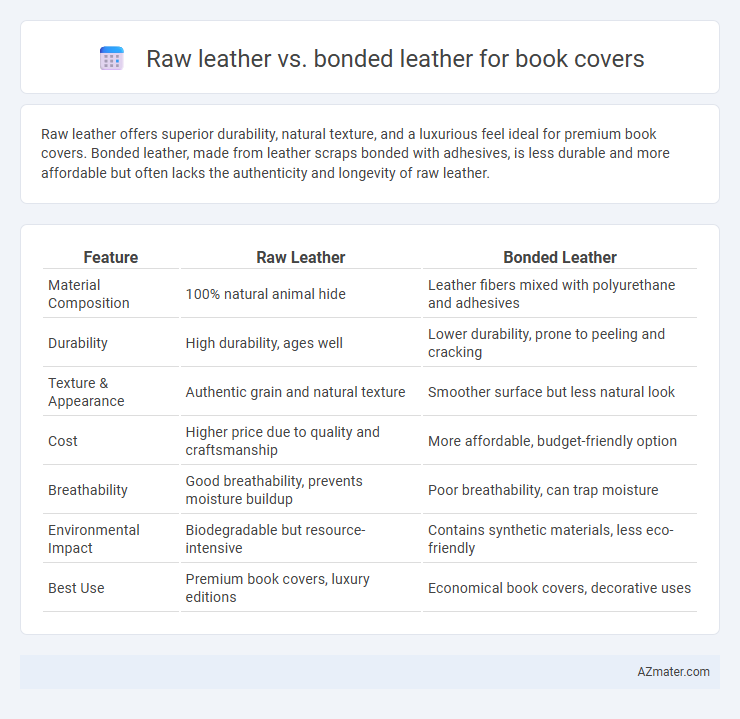Raw leather offers superior durability, natural texture, and a luxurious feel ideal for premium book covers. Bonded leather, made from leather scraps bonded with adhesives, is less durable and more affordable but often lacks the authenticity and longevity of raw leather.
Table of Comparison
| Feature | Raw Leather | Bonded Leather |
|---|---|---|
| Material Composition | 100% natural animal hide | Leather fibers mixed with polyurethane and adhesives |
| Durability | High durability, ages well | Lower durability, prone to peeling and cracking |
| Texture & Appearance | Authentic grain and natural texture | Smoother surface but less natural look |
| Cost | Higher price due to quality and craftsmanship | More affordable, budget-friendly option |
| Breathability | Good breathability, prevents moisture buildup | Poor breathability, can trap moisture |
| Environmental Impact | Biodegradable but resource-intensive | Contains synthetic materials, less eco-friendly |
| Best Use | Premium book covers, luxury editions | Economical book covers, decorative uses |
Introduction to Raw Leather and Bonded Leather
Raw leather, also known as full-grain leather, is made from the top layer of animal hide, retaining natural imperfections and durability, making it highly valued for premium book covers. Bonded leather consists of leather scraps and fibers bonded together with polyurethane or latex, offering a cheaper and less durable alternative with a uniform appearance. Understanding the material composition and longevity helps in selecting the best leather type for book cover applications.
Defining Raw Leather: Characteristics & Processing
Raw leather, also known as full-grain leather, is characterized by its natural surface, durability, and breathability, retaining the original grain and markings of the animal hide. The processing of raw leather involves tanning methods such as vegetable or chrome tanning, which stabilize and preserve the hide without sanding or buffing away the surface, ensuring strength and a unique patina over time. This makes raw leather a premium, long-lasting choice for book covers, combining aesthetic appeal with tactile richness.
Understanding Bonded Leather: Composition & Manufacturing
Bonded leather is created by combining leather scraps, fibers, and polyurethane or latex binders to form a composite material that mimics genuine leather's texture and appearance. This manufacturing process involves shredding leftover leather pieces, mixing them with adhesives, and applying the mixture to a fabric backing, resulting in a cost-effective, flexible, and uniform book cover material. Unlike raw leather, bonded leather offers consistent aesthetics but lacks the durability and natural aging characteristics of full-grain or top-grain leather.
Durability Comparison: Raw Leather vs Bonded Leather
Raw leather offers superior durability for book covers, characterized by its natural toughness and resistance to wear, ensuring long-lasting protection. Bonded leather, composed of scraps and fibers bonded together, tends to wear out quickly, peeling and cracking under frequent use. Choosing raw leather guarantees enhanced longevity and a premium feel compared to the less durable, synthetic blend of bonded leather.
Appearance and Texture: Aesthetic Differences
Raw leather exhibits a rich, natural grain and unique imperfections that create a premium, authentic appearance ideal for book covers seeking an artisanal touch. Bonded leather, composed of leather scraps fused with polyurethane, offers a uniform texture and consistent color but lacks the depth and tactile variation found in raw leather. The smooth, synthetic feel of bonded leather contrasts with the supple, slightly uneven surface of raw leather, impacting the book cover's overall aesthetic appeal and sensory experience.
Longevity and Aging: How Book Covers Hold Up
Raw leather book covers offer superior longevity and develop a rich patina over time, enhancing their aesthetic appeal and durability. Bonded leather, made from leather scraps bonded with polyurethane, tends to wear out faster, with its surface peeling and cracking after prolonged use. For long-lasting book protection and elegant aging, raw leather remains the preferred choice among bibliophiles and collectors.
Cost-Effectiveness: Price Comparison and Value
Raw leather book covers typically cost significantly more than bonded leather due to the use of genuine, full-grain materials that offer superior durability and aging qualities. Bonded leather, made from leather scraps bonded with polyurethane, presents a budget-friendly alternative but often sacrifices long-term resilience and aesthetic appeal. For cost-effectiveness, bonded leather suits low-cost, short-term projects while raw leather justifies higher investment through enhanced longevity and premium appearance.
Maintenance and Care Requirements
Raw leather book covers demand regular conditioning with natural oils to prevent drying and cracking, ensuring long-term durability and maintaining their rich texture. Bonded leather covers require gentler cleaning with mild soap and water, as harsh chemicals can cause the polyurethane layer to deteriorate and peel. Proper maintenance of raw leather extends its lifespan significantly, while bonded leather, though easier to clean, generally needs more frequent replacement due to its lower resilience.
Environmental Impact: Raw vs Bonded Leather
Raw leather, often derived from untreated animal hides, undergoes extensive tanning processes that can release harmful chemicals into the environment, impacting water and soil quality. Bonded leather, made from shredded leather scraps combined with synthetic materials and adhesives, typically involves less animal resource usage but relies on plastic binders that contribute to microplastic pollution and reduced biodegradability. Evaluating the environmental impact, raw leather's high resource intensity contrasts with bonded leather's synthetic components, making sustainable alternatives or recycled materials preferable for eco-conscious book cover production.
Choosing the Best Leather for Book Covers
Raw leather offers unmatched durability and a natural texture that enhances the longevity and aesthetic appeal of book covers, making it an ideal choice for premium editions. Bonded leather, crafted from leather scraps bonded with polyurethane, provides a budget-friendly alternative but lacks the resilience and authentic feel of raw leather. Selecting raw leather ensures superior wear resistance and a unique patina over time, while bonded leather may suffice for short-term use with controlled handling.

Infographic: Raw leather vs Bonded leather for Book cover
 azmater.com
azmater.com